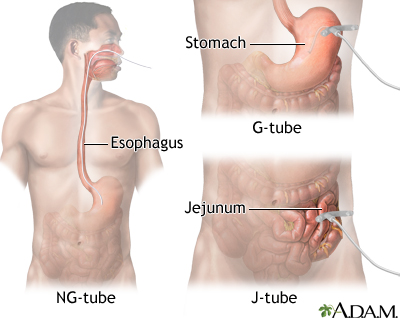Nasogastric feeding tube
Feeding - nasogastric tube; NG tube; Bolus feeding; Continuous pump feeding; Gavage tube
A nasogastric tube (NG tube) is a special tube that carries food and medicine to the stomach through the nose. It can be used for all feedings or for giving a person extra calories.
You'll learn to take good care of the tubing and the skin around the nostrils so that the skin (or nasal passages) don't get irritated.
Follow any specific instructions your health care provider gives you. Use the information below as a reminder of what to do.
Images

I Would Like to Learn About:
What to Expect at Home
If your child has an NG tube, try to keep your child from touching or pulling on the tube.
After your nurse teaches you how to flush the tube and perform skin care around the nose, set up a daily routine for these tasks.
Flushing the Tube
Flushing the tube helps release any formula stuck to the inside of the tube. Flush the tube after each feeding, or as often as your nurse recommends.
- First, wash your hands well with soap and water.
- After the feeding is finished, add warm water to the feeding syringe and let it flow by gravity.
- If the water does not go through, try changing positions a bit or attach the plunger to the syringe, and gently push the plunger part-way. Do not press all the way down or press fast.
- Remove the syringe.
- Close the NG tube cap.
Taking Care of the Skin
Follow these general guidelines:
- Clean the skin around the tube with warm water and a clean washcloth after each feeding. Remove any crust or secretions in the nose.
- When removing a bandage or dressing from the nose, loosen it first with a bit of mineral oil or other lubricant. Then gently remove the bandage or dressing. Afterward, wash the mineral oil off the nose.
- If you notice redness or irritation, try putting the tube in the other nostril, if your nurse taught you how to do this.
When to Call the Doctor
Contact your provider if any of the following occur:
- There is redness, swelling, and irritation in both nostrils
- The tube keeps getting clogged and you are unable to unclog it with water
- The tube falls out
- Vomiting
- Your stomach is bloated
Related Information
Crohn disease - dischargeReferences
Cederholm TE, Bosaeus IG. Malnutrition: assessment and support. In: Goldman L, Cooney KA, eds. Goldman-Cecil Medicine. 27th ed. Philadelphia, PA: Elsevier; 2024:chap 198.
BACK TO TOPReview Date: 10/11/2024
Reviewed By: Frank D. Brodkey, MD, FCCM, Associate Professor, Section of Pulmonary and Critical Care Medicine, University of Wisconsin School of Medicine and Public Health, Madison, WI. Also reviewed by David C. Dugdale, MD, Medical Director, Brenda Conaway, Editorial Director, and the A.D.A.M. Editorial team.

Health Content Provider
06/01/2025
|
A.D.A.M., Inc. is accredited by URAC, for Health Content Provider (www.urac.org). URAC's accreditation program is an independent audit to verify that A.D.A.M. follows rigorous standards of quality and accountability. A.D.A.M. is among the first to achieve this important distinction for online health information and services. Learn more about A.D.A.M.'s editorial policy, editorial process and privacy policy. A.D.A.M. is also a founding member of Hi-Ethics. This site complied with the HONcode standard for trustworthy health information from 1995 to 2022, after which HON (Health On the Net, a not-for-profit organization that promoted transparent and reliable health information online) was discontinued. |
The information provided herein should not be used during any medical emergency or for the diagnosis or treatment of any medical condition. A licensed medical professional should be consulted for diagnosis and treatment of any and all medical conditions. Links to other sites are provided for information only -- they do not constitute endorsements of those other sites. © 1997- 2025 A.D.A.M., a business unit of Ebix, Inc. Any duplication or distribution of the information contained herein is strictly prohibited.
